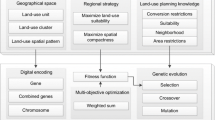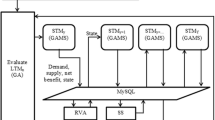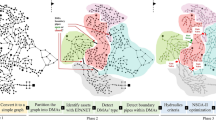Abstract
A general framework for a combined land use and water management is described. An optimization problem is formulated that combines combinatorial and spatial characteristics. The aim of the planning is to maximize economic benefit, while minimizing water extraction and transportation cost under ecological constraints. A genetic algorithm is employed endowed with a new neighborhood operator. This operator acts on a local level, but it produces global results. Although the computational scheme does not include compactness as a separate objective, compact patterns are produced as emergent results. The algorithm is tested on a fictive area represented as a grid with 15×15 land blocks and, also, on a real-world case study.











Similar content being viewed by others
References
Aerts, J. C. J. H., & Heuvelink, G. B. M. (2002). Using simulated annealing for resource allocation. International Journal of Geographical Information Science, 16(6), 571–587.
Aerts, J. C. J. H., et al. (2005). Evaluating spatial design techniques for solving land-use allocation problems. Journal of Environmental Planning and Management, 48(1), 121–142.
Brimberg, J., & Salhi, S. (2005). A continuous location-allocation problem with zone-dependent fixed cost. Annals of Operations Research, 136, 99–115.
Brookes, J. C. (1997). A parameterized region-growing programme for site allocation on raster suitability maps. International Journal of Geographical Information Science, 11(4), 375–396.
Datta, D., et al. (2007). Multi-objective evolutionary algorithm for land-use management problem. International Journal of Computational Intelligence Research, 3(4), 371–384.
Deb, K. (2000). An efficient constraint handling method for genetic algorithms. Computer Methods in Applied Mechanics and Engineering, 186, 311–338.
García-Alonso, C., Pérez-Naranjo, L. M., & Fernández-Caballero, J. C. (2011). Multiobjective evolutionary algorithms to identify highly autocorrelated areas: the case of spatial distribution in financially compromised farms. Annals of Operations Research, doi:10.1007/s10479-011-0841-3.
Gendreau, M., & Potvin, J. Y. (2005). Metaheuristics in combinatorial optimization. Annals of Operations Research, 140, 189–213.
Goldberg, D. E. (1989). Genetic algorithms for search, optimization, and machine learning. Reading: Addison-Wesley.
Holland, J. H. (1998). Emergence. From chaos to order. London: Oxford University Press.
Jankowski, P. (1995). Integrating geographical information systems and multiple criteria decision-making methods. International Journal of Geographical Information Science, 9(3), 251–273.
Li, X., & Yeh, A. G. (2005). Integration of genetic algorithms and GIS for optimal location search. International Journal of Geographical Information Science, 19(5), 581–601.
Ligmann-Zielinska, A., Church, R. L., & Jankowski, P. (2008). Spatial optimization as a generative technique for sustainable multiobjective land-use allocation. International Journal of Geographical Information Science, 22(6), 601–622.
Malczewski, J. (2004). GIS-based land-use suitability analysis: a critical overview. Progress in Planning, 62, 3–65.
Markou, M., & Papadavid, G. (2007). Norm input–output for the main crop and livestock enterprises of Cyprus. Agricultural economics report 46. Agricultural Research Institute, Ministry of Agriculture, Natural Resources and Environment.
Matthews, B. K., Sibbald, R. A., & Craw, S. (1999). Implementation of a spatial decision support system for rural land use planning: integrating geographic information system and environmental models with search and optimisation algorithms. Computers and Electronics in Agriculture, 23, 9–26.
Michalewich, Z. (1999). Genetic algorithms + data structures = evolution programs. Berlin: Springer.
Myronidis, D., & Arabatzis, G. (2009). An evaluation of the Greek post fire erosion mitigation policy through spatial analysis. Polish Journal of Environmental Studies, 18(5), 865–872.
Ortega, J. F., et al. (2004). MOPECO: an economic optimization model for irrigation water management. Irrigation Science, 23(2), 61–75.
Polubarinova-Kochina, P. (1962). Theory of ground water movement. Princeton: Princeton University Press.
Radulescu, M., Radulescu, C. Z., & Zbaganu, G. (2011). A portfolio theory approach to crop planning under environmental constraints. Annals of Operations Research, doi:10.1007/s10479-011-0902-7.
Riveira, I. S., Magan, M. B., Maseda, R. C., & Barros, D. M. (2008). Algorithm based on simulated annealing for land-use allocation. Computers & Geosciences, 34, 259–268.
Sidiropoulos, E., & Fotakis, D. (2009). Cell-based genetic algorithm and simulated annealing for spatial groundwater allocation. Transactions on Environment and Development, 4, 5.
Sidiropoulos, E., & Tolikas, P. (2008). Genetic algorithms and cellular automata in aquifer management. Applied Mathematical Modelling, 32(4), 617–640.
Stewart, T. J., Janssen, R., & Van Herwijnen, M. (2004). A genetic algorithm approach to multiobjective land use planning. Computers & Operations Research, 31(14), 2293–2313.
Suiadee, W., & Tingsanchali, T. (2007). A combined simulation–genetic algorithm optimization model for optimal rule curves of a reservoir: a case study of the Nam Oon Irrigation Project, Thailand. Hydrological Processes, 21, 3211–3225.
Tindell, K. W., Burns, A., & Wellings, A. J. (1992). Allocating hard real-time tasks: an NP-hard problem made easy. Real-Time Systems, 4, 145–165.
Venema, H. D., & Calamai, P. H. (2003). Bioenergy systems planning using location–allocation and landscape ecology design principles. Annals of Operations Research, 123, 241–264.
Wu, J., Zheng, L., & Liu, D. (2007). Optimizing groundwater development strategies by genetic algorithm: a case study for balancing the needs for agricultural irrigation and environmental protection in northern China. Hydrogeology Journal, 15, 1265–1278.
Zhou, H., Peng, H., & Zhang, C. (2007). In LNCS: Vol. 4688. An interactive fuzzy multi-objective optimization approach for crop planning and water resources allocation (pp. 335–346).
Author information
Authors and Affiliations
Corresponding author
Rights and permissions
About this article
Cite this article
Fotakis, D., Sidiropoulos, E. Combined land-use and water allocation planning. Ann Oper Res 219, 169–185 (2014). https://doi.org/10.1007/s10479-012-1080-y
Published:
Issue Date:
DOI: https://doi.org/10.1007/s10479-012-1080-y




